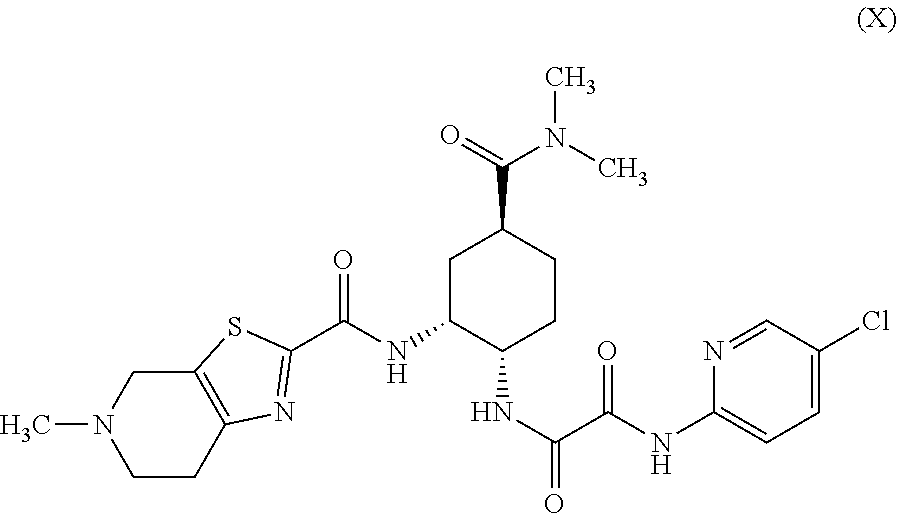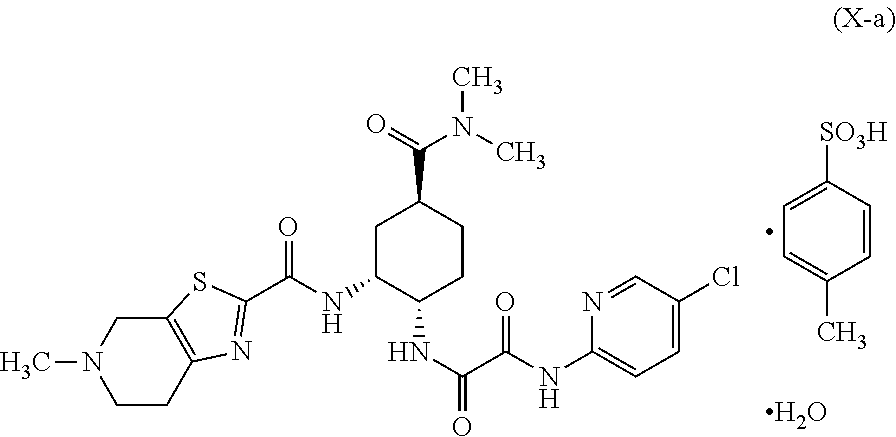Preparation method of optically active diamine compound
- Summary
- Abstract
- Description
- Claims
- Application Information
AI Technical Summary
Benefits of technology
Problems solved by technology
Method used
Image
Examples
reference example 1
(1S,4S,5S)-4-Bromo-6-oxabicyclo[3.2.1]octan-7-one
[0118]
[0119]Under a nitrogen atmosphere, 1,3-dibromo-5,5-dimethylhydantoin (4) (11.6 g, 40.6 mol) was added to a solution of (S)-3-cyclohexene-1-carboxylic acid (R)-α-phenylethylamine salt (2-b) (10.0 g, 40.4 mmol) in acetonitrile (25 ml) that had been cooled on ice. The temperature of the reaction solution was increased to room temperature, and the reaction solution was then stirred for 2 hours. Thereafter, ethyl acetate (50 ml) and a 10% sodium thiosulfate aqueous solution (40 ml) were added to the reaction solution to separate it. The aqueous layer was extracted with ethyl acetate (50 ml), and the organic layers were gathered and were then washed with a 5% citric acid aqueous solution (40 ml). The resulting organic layer was washed with saturated saline (30 ml) and was then concentrated under reduced pressure. Thereafter, isopropyl alcohol (50 ml) was added to the residue, and the solvent was then concentrated under reduced pressur...
reference example 2
(1S,3S,4S)-3-Hydroxy-4-bromo-N,N-dimethylcyclohexanecarboxamide
[0121]
[0122]Ethyl acetate (1250 ml) was cooled to 5° C., and (1S,4S,5S)-4-bromo-6-oxabicyclo[3.2.1]octan-7-one (250 g) was then added thereto. Thereafter, a 50% dimethylamine aqueous solution (382 ml) was added to the above obtained solution, and the obtained mixture was then stirred for 14 hours. Thereafter, citric acid (234.2 g), 20% saline (500 ml), and ethyl acetate (625 ml) were added to the reaction mixture, and the obtained mixture was then stirred for 30 minutes, so that the organic layer was separated. Further, the aqueous layer was extracted with ethyl acetate (1875 ml). The organic layers were gathered, and the gathered organic layer was then concentrated to 1250 ml. Thereafter, water (500 ml) was added to the concentrated solution, and the mixed solution was then concentrated again to obtain the title compound (274.5 g, yield: 90%) in the form of an aqueous solution (625 ml).
[0123]Moreover, the present compo...
reference example 3
(1S,3S,6R)—N,N-Dimethyl-7-oxabicyclo[4.1.0]heptane-3-carboxamide
[0127]
[0128]Methylene chloride (125 mL) was cooled to 0° C., and (1S,3S,4S)-3-hydroxy-4-bromo-N,N-dimethylcyclohexanecarboxamide (25 g) was then added thereto. Thereafter, a 25% sodium hydroxide aqueous solution (16 mL) was added to the above obtained solution, and the temperature of the obtained mixture was then increased to room temperature, followed by stirring the mixture for 3 hours. Thereafter, the organic layer was separated from the reaction mixture, and was then concentrated and dried to solidify. Thereafter, the resultant was dissolved in ethyl acetate (100 mL), and was then filtered over silica gel (25 g). The filtrate was concentrated and dried to solidify, and heptane (250 ml) was then added thereto, followed by crystallization, to obtain the title compound (13.91 g, yield: 82%).
[0129]1H-NMR (CDCl3) δ: 1.40-1.46 (1H, m), 1.56-1.67 (1H, m), 1.73-1.85 (1H, m), 1.96-2.03 (1H, m), 2.17-2.25 (2H, m), 2.41-2.49 (...
PUM
| Property | Measurement | Unit |
|---|---|---|
| Time | aaaaa | aaaaa |
| Time | aaaaa | aaaaa |
Abstract
Description
Claims
Application Information
 Login to View More
Login to View More - R&D
- Intellectual Property
- Life Sciences
- Materials
- Tech Scout
- Unparalleled Data Quality
- Higher Quality Content
- 60% Fewer Hallucinations
Browse by: Latest US Patents, China's latest patents, Technical Efficacy Thesaurus, Application Domain, Technology Topic, Popular Technical Reports.
© 2025 PatSnap. All rights reserved.Legal|Privacy policy|Modern Slavery Act Transparency Statement|Sitemap|About US| Contact US: help@patsnap.com



